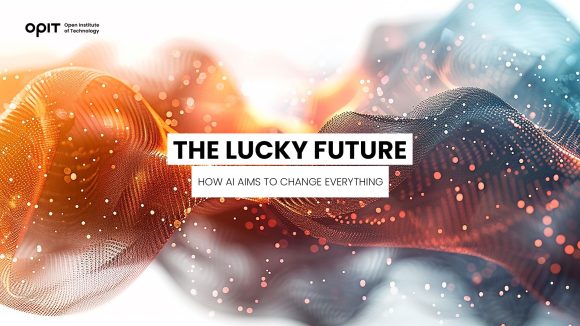

There is no question that the spread of artificial intelligence (AI) is having a profound impact on nearly every aspect of our lives.
But is an AI-powered future one to be feared, or does AI offer the promise of a “lucky future.”
That “lucky future” prediction comes from Zorina Alliata, principal AI Strategist at Amazon and AI faculty member at Georgetown University and the Open Institute of Technology (OPIT), in her recent webinar “The Lucky Future: How AI Aims to Change Everything” (February 18, 2025).
However, according to Alliata, such a future depends on how the technology develops and whether strategies can be implemented to mitigate the risks.
How AI Aims to Change Everything
For many people, AI is already changing the way they work. However, more broadly, AI has profoundly impacted how we consume information.
From the curation of a social media feed and the summary answer to a search query from Gemini at the top of your Google results page to the AI-powered chatbot that resolves your customer service issues, AI has quickly and quietly infiltrated nearly every aspect of our lives in the past few years.
While there have been significant concerns recently about the possibly negative impact of AI, Alliata’s “lucky future” prediction takes these fears into account. As she detailed in her webinar, a future with AI will have to take into consideration:
- Where we are currently with AI and future trajectories
- The impact AI is having on the job landscape
- Sustainability concerns and ethical dilemmas
- The fundamental risks associated with current AI technology
According to Alliata, by addressing these risks, we can craft a future in which AI helps individuals better align their needs with potential opportunities and limitations of the new technology.
Industry Applications of AI
While AI has been in development for decades, Alliata describes a period known as the “AI winter” during which educators like herself studied AI technology, but hadn’t arrived at a point of practical applications. Contributing to this period of uncertainty were concerns over how to make AI profitable as well.
That all changed about 10-15 years ago when machine learning (ML) improved significantly. This development led to a surge in the creation of business applications for AI. Beginning with automation and robotics for repetitive tasks, the technology progressed to data analysis – taking a deep dive into data and finding not only new information but new opportunities as well.
This further developed into generative AI capable of completing creative tasks. Generative AI now produces around one billion words per day, compared to the one trillion produced by humans.
We are now at the stage where AI can complete complex tasks involving multiple steps. In her webinar, Alliata gave the example of a team creating storyboards and user pathways for a new app they wanted to develop. Using photos and rough images, they were able to use AI to generate the code for the app, saving hundreds of hours of manpower.
The next step in AI evolution is Artificial General Intelligence (AGI), an extremely autonomous level of AI that can replicate or in some cases exceed human intelligence. While the benefits of such technology may readily be obvious to some, the industry itself is divided as to not only whether this form of AI is close at hand or simply unachievable with current tools and technology, but also whether it should be developed at all.
This unpredictability, according to Alliata, represents both the excitement and the concerns about AI.
The AI Revolution and the Job Market
According to Alliata, the job market is the next area where the AI revolution can profoundly impact our lives.
To date, the AI revolution has not resulted in widespread layoffs as initially feared. Instead of making employees redundant, many jobs have evolved to allow them to work alongside AI. In fact, AI has also created new jobs such as AI prompt writer.
However, the prediction is that as AI becomes more sophisticated, it will need less human support, resulting in a greater job churn. Alliata shared statistics from various studies predicting as many as 27% of all jobs being at high risk of becoming redundant from AI and 40% of working hours being impacted by language learning models (LLMs) like Chat GPT.
Furthermore, AI may impact some roles and industries more than others. For example, one study suggests that in high-income countries, 8.5% of jobs held by women were likely to be impacted by potential automation, compared to just 3.9% of jobs held by men.
Is AI Sustainable?
While Alliata shared the many ways in which AI can potentially save businesses time and money, she also highlighted that it is an expensive technology in terms of sustainability.
Conducting AI training and processing puts a heavy strain on central processing units (CPUs), requiring a great deal of energy. According to estimates, Chat GPT 3 alone uses as much electricity per day as 121 U.S. households in an entire year. Gartner predicts that by 2030, AI could consume 3.5% of the world’s electricity.
To reduce the energy requirements, Alliata highlighted potential paths forward in terms of hardware optimization, such as more energy-efficient chips, greater use of renewable energy sources, and algorithm optimization. For example, models that can be applied to a variety of uses based on prompt engineering and parameter-efficient tuning are more energy-efficient than training models from scratch.
Risks of Using Generative AI
While Alliata is clearly an advocate for the benefits of AI, she also highlighted the risks associated with using generative AI, particularly LLMs.
- Uncertainty – While we rely on AI for answers, we aren’t always sure that the answers provided are accurate.
- Hallucinations – Technology designed to answer questions can make up facts when it does not know the answer.
- Copyright – The training of LLMs often uses copyrighted data for training without permission from the creator.
- Bias – Biased data often trains LLMs, and that bias becomes part of the LLM’s programming and production.
- Vulnerability – Users can bypass the original functionality of an LLM and use it for a different purpose.
- Ethical Risks – AI applications pose significant ethical risks, including the creation of deepfakes, the erosion of human creativity, and the aforementioned risks of unemployment.
Mitigating these risks relies on pillars of responsibility for using AI, including value alignment of the application, accountability, transparency, and explainability.
The last one, according to Alliata, is vital on a human level. Imagine you work for a bank using AI to assess loan applications. If a loan is denied, the explanation you give to the customer can’t simply be “Because the AI said so.” There needs to be firm and explainable data behind the reasoning.
OPIT’s Masters in Responsible Artificial Intelligence explores the risks and responsibilities inherent in AI, as well as others.
A Lucky Future
Despite the potential risks, Alliata concludes that AI presents even more opportunities and solutions in the future.
Information overload and decision fatigue are major challenges today. Imagine you want to buy a new car. You have a dozen features you desire, alongside hundreds of options, as well as thousands of websites containing the relevant information. AI can help you cut through the noise and narrow the information down to what you need based on your specific requirements.
Alliata also shared how AI is changing healthcare, allowing patients to understand their health data, make informed choices, and find healthcare professionals who meet their needs.
It is this functionality that can lead to the “lucky future.” Personalized guidance based on an analysis of vast amounts of data means that each person is more likely to make the right decision with the right information at the right time.
Related posts

Source:
- Agenda Digitale, published on November 25th, 2025
In recent years, the word ” sustainability ” has become a firm fixture in the corporate lexicon. However, simply “doing no harm” is no longer enough: the climate crisis , social inequalities , and the erosion of natural resources require a change of pace. This is where the net-positive paradigm comes in , a model that isn’t content to simply reduce negative impacts, but aims to generate more social and environmental value than is consumed.
This isn’t about philanthropy, nor is it about reputational makeovers: net-positive is a strategic approach that intertwines economics, technology, and corporate culture. Within this framework, digitalization becomes an essential lever, capable of enabling regenerative models through circular platforms and exponential technologies.
Blockchain, AI, and IoT: The Technological Triad of Regeneration
Blockchain, Artificial Intelligence, and the Internet of Things represent the technological triad that makes this paradigm shift possible. Each addresses a critical point in regeneration.
Blockchain guarantees the traceability of material flows and product life cycles, allowing a regenerated dress or a bottle collected at sea to tell their story in a transparent and verifiable way.
Artificial Intelligence optimizes recovery and redistribution chains, predicting supply and demand, reducing waste and improving the efficiency of circular processes .
Finally, IoT enables real-time monitoring, from sensors installed at recycling plants to sharing mobility platforms, returning granular data for quick, informed decisions.
These integrated technologies allow us to move beyond linear vision and enable systems in which value is continuously regenerated.
New business models: from product-as-a-service to incentive tokens
Digital regeneration is n’t limited to the technological dimension; it’s redefining business models. More and more companies are adopting product-as-a-service approaches , transforming goods into services: from technical clothing rentals to pay-per-use for industrial machinery. This approach reduces resource consumption and encourages modular design, designed for reuse.
At the same time, circular marketplaces create ecosystems where materials, components, and products find new life. No longer waste, but input for other production processes. The logic of scarcity is overturned in an economy of regenerated abundance.
To complete the picture, incentive tokens — digital tools that reward virtuous behavior, from collecting plastic from the sea to reusing used clothing — activate global communities and catalyze private capital for regeneration.
Measuring Impact: Integrated Metrics for Net-Positiveness
One of the main obstacles to the widespread adoption of net-positive models is the difficulty of measuring their impact. Traditional profit-focused accounting systems are not enough. They need to be combined with integrated metrics that combine ESG and ROI, such as impact-weighted accounting or innovative indicators like lifetime carbon savings.
In this way, companies can validate the scalability of their models and attract investors who are increasingly attentive to financial returns that go hand in hand with social and environmental returns.
Case studies: RePlanet Energy, RIFO, and Ogyre
Concrete examples demonstrate how the combination of circular platforms and exponential technologies can generate real value. RePlanet Energy has defined its Massive Transformative Purpose as “Enabling Regeneration” and is now providing sustainable energy to Nigerian schools and hospitals, thanks in part to transparent blockchain-based supply chains and the active contribution of employees. RIFO, a Tuscan circular fashion brand, regenerates textile waste into new clothing, supporting local artisans and promoting workplace inclusion, with transparency in the production process as a distinctive feature and driver of loyalty. Ogyre incentivizes fishermen to collect plastic during their fishing trips; the recovered material is digitally tracked and transformed into new products, while the global community participates through tokens and environmental compensation programs.
These cases demonstrate how regeneration and profitability are not contradictory, but can actually feed off each other, strengthening the competitiveness of businesses.
From Net Zero to Net Positive: The Role of Massive Transformative Purpose
The crucial point lies in the distinction between sustainability and regeneration. The former aims for net zero, that is, reducing the impact until it is completely neutralized. The latter goes further, aiming for a net positive, capable of giving back more than it consumes.
This shift in perspective requires a strong Massive Transformative Purpose: an inspiring and shared goal that guides strategic choices, preventing technology from becoming a sterile end. Without this level of intentionality, even the most advanced tools risk turning into gadgets with no impact.
Regenerating business also means regenerating skills to train a new generation of professionals capable not only of using technologies but also of directing them towards regenerative business models. From this perspective, training becomes the first step in a transformation that is simultaneously cultural, economic, and social.
The Regenerative Future: Technology, Skills, and Shared Value
Digital regeneration is not an abstract concept, but a concrete practice already being tested by companies in Europe and around the world. It’s an opportunity for businesses to redefine their role, moving from mere economic operators to drivers of net-positive value for society and the environment.
The combination of blockchain, AI, and IoT with circular product-as-a-service models, marketplaces, and incentive tokens can enable scalable and sustainable regenerative ecosystems. The future of business isn’t just measured in terms of margins, but in the ability to leave the world better than we found it.

Source:
- Raconteur, published on November 06th, 2025
Many firms have conducted successful Artificial Intelligence (AI) pilot projects, but scaling them across departments and workflows remains a challenge. Inference costs, data silos, talent gaps and poor alignment with business strategy are just some of the issues that leave organisations trapped in pilot purgatory. This inability to scale successful experiments means AI’s potential for improving enterprise efficiency, decision-making and innovation isn’t fully realised. So what’s the solution?
Although it’s not a magic bullet, an AI operating model is really the foundation for scaling pilot projects up to enterprise-wide deployments. Essentially it’s a structured framework that defines how the organisation develops, deploys and governs AI. By bringing together infrastructure, data, people, and governance in a flexible and secure way, it ensures that AI delivers value at scale while remaining ethical and compliant.
“A successful AI proof-of-concept is like building a single race car that can go fast,” says Professor Yu Xiong, chair of business analytics at the UK-based Surrey Business School. “An efficient AI technology operations model, however, is the entire system – the processes, tools, and team structures – for continuously manufacturing, maintaining, and safely operating an entire fleet of cars.”
But while the importance of this framework is clear, how should enterprises establish and embed it?
“It begins with a clear strategy that defines objectives, desired outcomes, and measurable success criteria, such as model performance, bias detection, and regulatory compliance metrics,” says Professor Azadeh Haratiannezhadi, co-founder of generative AI company Taktify and professor of generative AI in cybersecurity at OPIT – the Open Institute of Technology.
Platforms, tools and MLOps pipelines that enable models to be deployed, monitored and scaled in a safe and efficient way are also essential in practical terms.
“Tools and infrastructure must also be selected with transparency, cost, and governance in mind,” says Efrain Ruh, continental chief technology officer for Europe at Digitate. “Crucially, organisations need to continuously monitor the evolving AI landscape and adapt their models to new capabilities and market offerings.”
An open approach
The most effective AI operating models are also founded on openness, interoperability and modularity. Open source platforms and tools provide greater control over data, deployment environments and costs, for example. These characteristics can help enterprises to avoid vendor lock-in, successfully align AI to business culture and values, and embed it safely into cross-department workflows.
“Modularity and platformisation…avoids building isolated ‘silos’ for each project,” explains professor Xiong. “Instead, it provides a shared, reusable ‘AI platform’ that integrates toolchains for data preparation, model training, deployment, monitoring, and retraining. This drastically improves efficiency and reduces the cost of redundant work.”
A strong data strategy is equally vital for ensuring high-quality performance and reducing bias. Ideally, the AI operating model should be cloud and LLM agnostic too.
“This allows organisations to coordinate and orchestrate AI agents from various sources, whether that’s internal or 3rd party,” says Babak Hodjat, global chief technology officer of AI at Cognizant. “The interoperability also means businesses can adopt an agile iterative process for AI projects that is guided by measuring efficiency, productivity, and quality gains, while guaranteeing trust and safety are built into all elements of design and implementation.”
A robust AI operating model should feature clear objectives for compliance, security and data privacy, as well as accountability structures. Richard Corbridge, chief information officer of Segro, advises organisations to: “Start small with well-scoped pilots that solve real pain points, then bake in repeatable patterns, data contracts, test harnesses, explainability checks and rollback plans, so learning can be scaled without multiplying risk. If you don’t codify how models are approved, deployed, monitored and retired, you won’t get past pilot purgatory.”
Of course, technology alone can’t drive successful AI adoption at scale: the right skills and culture are also essential for embedding AI across the enterprise.
“Multidisciplinary teams that combine technical expertise in AI, security, and governance with deep business knowledge create a foundation for sustainable adoption,” says Professor Haratiannezhadi. “Ongoing training ensures staff acquire advanced AI skills while understanding associated risks and responsibilities.”
Ultimately, an AI operating model is the playbook that enables an enterprise to use AI responsibly and effectively at scale. By drawing together governance, technological infrastructure, cultural change and open collaboration, it supports the shift from isolated experiments to the kind of sustainable AI capability that can drive competitive advantage.
In other words, it’s the foundation for turning ambition into reality, and finally escaping pilot purgatory for good.
Have questions?
Visit our FAQ page or get in touch with us!
Write us at +39 335 576 0263
Get in touch at hello@opit.com
Talk to one of our Study Advisors
We are international
We can speak in:


